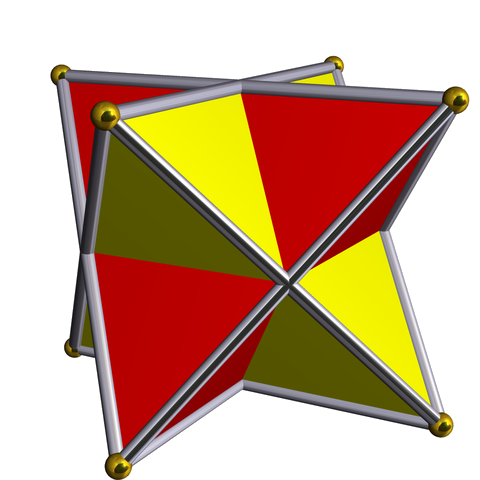
When bad news gets me down, I often get insomnia. I wake up in the middle of the night, start thinking about how we're all doomed, and can't easily stop. To break out of these doom loops, I do elaborate visualization exercises. They don't really put me to sleep, they just calm me down. Then later I can fall asleep.
Here's what I've been doing this week. I visualize this shape made of two interpenetrating tetrahedra, called the 'stella octangula' or 'stellated octahedron'. Notice that these two tetrahedra are 'dual': each corner of the yellow one is above the center of a triangle in the red one, and vice versa.
Then I imagine the yellow tetrahedron moving 'up' into the 4th dimension while the red one moves 'down'. At some point the distance between each corner of the yellow tetrahedron to the 3 nearest corners of the red one equals the distance between any 2 corners of the yellow tetrahedron. Then I've got a 4d shape called the 'cross-polytope'. All its faces are regular tetrahedra.
There are easier ways to think about the cross-polytope, which is one of the six 4-dimensional regular polytopes. So the real challenge is to visualize how this way of getting it leads to the same result.
My go-to way to think about the cross-polytope is to imagine the 4 coordinate axes in 4-dimensional space and put two dots on each axis, one unit away from the origin in each direction:
These are the vertices of a cross-polytope. It's the 4d analogue of an octahedron. Just as the octahedron has equilateral triangles as faces, this guy has regular tetrahedra as faces. Can you see those tetrahedra in this picture, and count them? Don't worry — if you're too busy now, you can do it when you're lying in bed at 3 am thinking about global warming and the decline of democracy. Start by visualizing this picture:
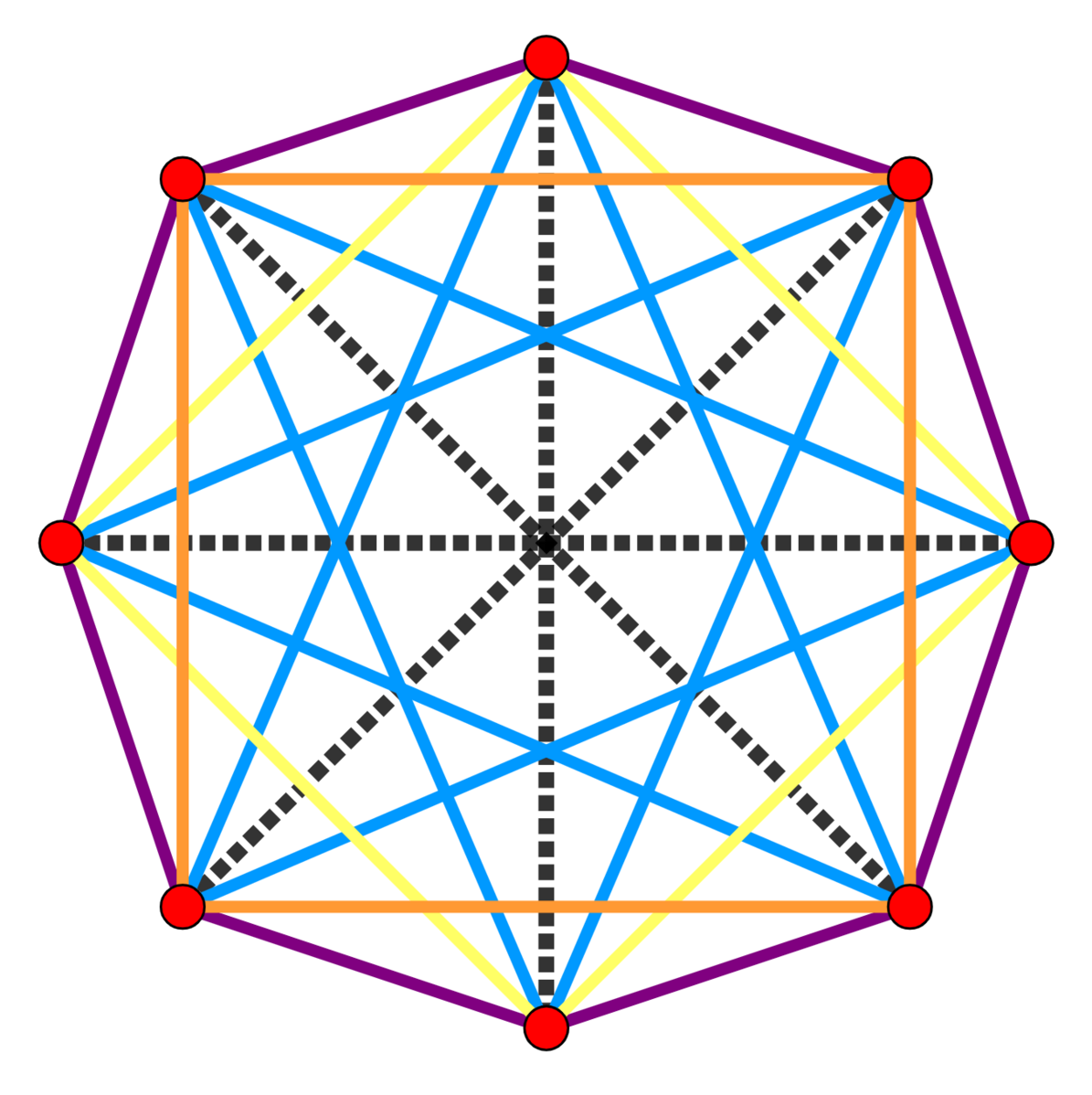
But the hard part is to visualize the cross-polytope this way and then rotate it in your mind so you see it as made of two tetrahedra, one red and one yellow, and an edge connecting each vertex of the red one to the 3 nearest vertices of the yellow one. That's been keeping me busy all week.
By the way, everything I just said has a 3d version! The 3d analogue of the cross-polytope is a regular octahedron. The corners of a regular octahedron are
But here's a flattened picture of an octahedron:
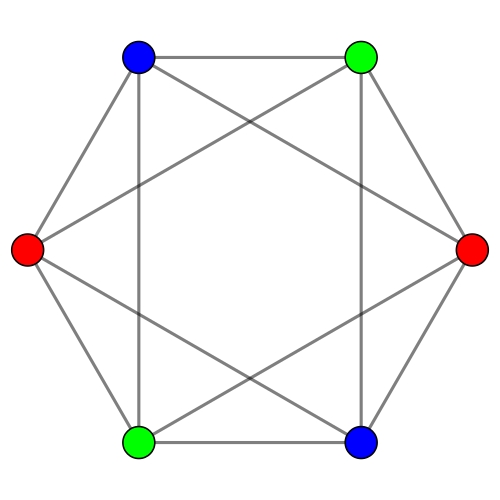
See the two interpenetrating equilateral triangles? If you move one up, and move one down, they can become two opposite faces of a regular octahedron.
Actually this sort of trick works in any dimension. Take two regular \(n\)-simplexes, dual to each other and interpenetrating; then move one 'up' into the \((n+1)\)st dimension, and the other 'down'. At some point their vertices will be the vertices of an \((n+1\))-dimensional cross-polytope. In 3 dimensions this is easy for me to visualize, while in 4 dimensions I can just barely visualize it... though it's getting easier every night.
August 13, 2025
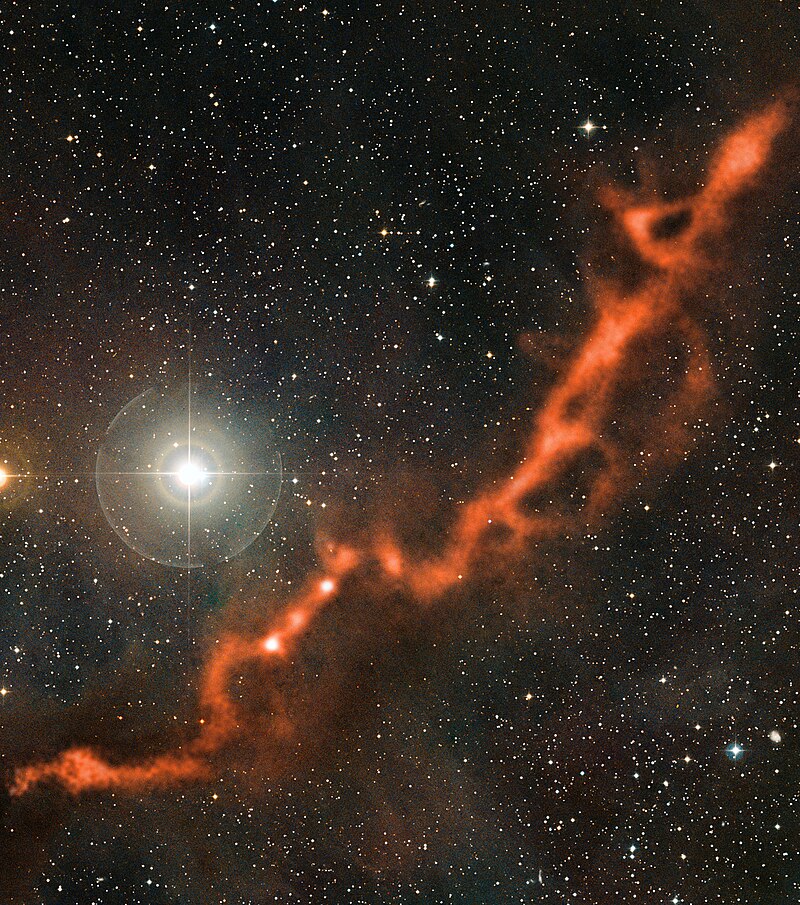
This image shows a filament of cosmic dust over ten light years long! It's part of a giant cloud of cold gas and dust that's starting to collapse under its own gravity to form stars. Newborn stars are hidden inside. The cosmic dust grains here are so cold that observations at millimeter wavelengths were needed to detect their faint glow, shown as orange in this false-color image.
Giant molecular clouds like this range from 15 to 600 light-years across. And they're very dense... for outer space, that is. While space in the Solar System has about one atom per cubic centimeter, a giant molecular cloud has between 10 or 1000, and this shoots up in regions that are collapsing. The total mass of a giant molecular cloud can thus be huge: over 10,000 times that of the Sun.
As a giant molecular cloud collapses, it forms filaments and clumps. The dense parts of these filaments and clumps are called 'molecular cores'. These can easily have 1000 to 1,000,000 particles per cubic centimeter. Of course this rises much higher in regions where stars are formed.
Somewhere like this is where our Solar System was born. The dust grains became our Earth. Some of the complex organic compounds floating around became you and me.
But this one is in the constellation of Taurus. It's called the Taurus molecular cloud, and hundreds of new stars are being born here:
Most of the gas in a giant molecular cloud is molecular hydrogen, helium, and carbon monoxide. They also contain methanol, ethanol, benzene, ammonia and other things. The dust is mainly silicates, iron and organic compounds along with some ices. Next time I'll tell you about polycyclic aromatic hydrocarbons, which get pretty complicated and interesting.
August 14, 2025
In 2004, a team of scientists discovered hydrocarbons called anthracene and pyrene in an amazing structure called the Red Rectangle!
Here two stars 2300 light years from us are spinning around each other while pumping out a huge torus of icy dust grains and hydrocarbon molecules. It's not really shaped like a rectangle or X — it just looks that way from here. The whole scene is about one third of a light year across.
This was the first time such complex molecules had been found in space:
Wherever carbon-containing materials suffer incomplete combustion, you get PAHs, or polycyclic aromatic hydrocarbons. In Earth you can find them in soot, or the tarry stuff that forms in a barbecue grill. They're common in outer space, too.
But what are PAHs like, exactly? They're made of hexagonal rings of carbon atoms, with some hydrogens along the edges:
Benzene has a single hexagonal ring, with 6 carbons and 6 hydrogens. You've probably heard about naphthalene, which is used for mothballs: this consists of two hexagonal rings stuck together. True PAHs have more. With three rings you can make anthracene:
and phenanthrene:
With four, you can make napthacene:
pyrene:
triphenylene:
and chrysene:
And so on! The game just gets more complicated as you get to use more puzzle pieces.
By now, lots of organic molecules have been found in interstellar or circumstellar space. There's a whole 'ecology' of organic chemicals out there, engaged in complex reactions. Life on planets might someday be seen as just an aspect of this larger ecology. PAHs are probably among the dominant players in this ecology, at least at this stage.
Indeed, I've read that about 10% of the interstellar carbon is in the form of PAHs — big ones, with about 50 carbons per molecule. They're common because they're incredibly stable. They've even been found riding the shock wave of a supernova explosion!
PAHs are also found in meteorites called 'carbonaceous chondrites’. These space rocks contain just a little carbon: about 3% by weight. But 80% of this carbon is in the form of PAHs.
Here's an interview with a scientist who thinks PAHs were important precursors of life on Earth:
Astronomers have found a truly huge black hole! It's in the massive galaxy in the center here, called the Cosmic Horseshoe. The blue ring is light from a galaxy behind the Cosmic Horseshoe, severely bent by gravity.
This black hole is 36 billion times the mass of the Sun. It's not just 'supermassive': any black hole over 10 billion times the Sun's mass is considered 'ultramassive'. Not many have been found.
To me the coolest part is that the Cosmic Horseshoe has swallowed all the other galaxies in its group: it's part of something called a 'fossil group', which I hadn't heard about until today.
Our galaxy, the Milky Way, is part of a group too: the Local Group. Many smaller galaxies have already fallen into ours. Eventually the Milky Way and Andromeda may collide and form a single bigger galaxy. This will be an elliptical galaxy — too disorganized to have spiral arms. So it's not surprising that if you wait long enough, galaxy groups form a single big elliptical galaxy which eventually eats the rest.
Some ancient galaxy groups have already done this, and they're called 'fossil groups'. The Cosmic Horseshoe is the big bully in this particular fossil group: it's 100 times heavier than the Milky Way. It's surrounded by a halo of very hot gas, 10 million Kelvin, emitting lots of X rays. But most of its mass can't be explained by stars, gas and dust, so we say 90% is dark matter. All this is completely typical of a fossil group, except the Cosmic Horseshoe is bigger than average.
Fossil groups show us what the future will be like. Big galaxies will eat the rest, and big black holes at the center of these galaxies will eventually eat most of the matter. Dark matter — whatever that is — takes longer to fall in. But there's plenty of time.
Here's the new paper about this ultramassive black hole. Luckily, it's free to read:
Below is a picture from this paper. The blue blob in a box at left is called the 'counter-image' of the galaxy that's making the Einstein ring. When light from behind a massive body is bent by gravity, it often forms a ring, called an 'Einstein ring', together with a counter-image.
I've always been fond of cryptozoology — the study of probably mythological animals like the Loch Ness monster — but I'm happiest when these creatures turn out to be real, or at least based on real animals. So I'm surprised I'd never heard about the Cat Sith and the Kellas cat.
The 'Cat Sith' was a creature from Celtic mythology. It looked like large black cat with a white spot on its chest. But when it thought no humans were watching, it would walk on its hind legs. They were fierce, and would attack at the slightest provocation. On Samhain — the original name for Halloween — they would roam the land at night. Wise families would leave a bowl of milk out for them.
But as Christianity took hold, the Cat Sith's identity began to change. Instead of being a fairy cat, the Cat Sith became a witch who could shapeshift into a cat. She could do this 8 times — but if she did it a 9th time, she'd be stuck in that form forever. This may be where the myth that a cat has 9 lives comes from.
By the 20th century, few believed in the Cat Sith... until they found one! Now it's stuffed in the Zoology Museum in Aberdeen. See the picture.
It's a large black cat with a white spot on its chest. Others have been found. They're called 'Kellas cats'. They're a hybrid of the domestic cat and the Scottish wildcat, a critically endangered population of the European wildcat Felis silvestris.
Scottish wildcats have been present in Britain since the early Holocene, when the British Isles were connected to Europe by Doggerland. By 1915, they were found only northwestern Scotland. But now their range has increased, and they're being bred in captivity and released!
This is a great intro to the myth and reality of the Cat Sith:
Newcastle writes:
In 1985, Ronnie Douglas, a gamekeeper in Kellas, Moray, was stunned to find a large, black cat with a white chest patch in one of his snares. About a year later, a live one was caught by the Tomorrows World team. Soon, a total of seven additional specimens were collected by alien big cat researcher (in this case, "alien" as in " not supposed to be from around here,” not as in, "extraterrestrials made a pit stop here so their pets could go to the bathroom”) Di Francis, who gave them all to the National Museum of Scotland. There, studies revealed that some of the "Cat Siths" were actually a cross between a domestic cat and a Scottish wildcat. They were then named the Kellas cat by cryptozoologist Karl Shuker after the village where the first one had been found."
Also check out the Wikipedia articles on the Cat Sith, the Kellas cat and Scottish wildcat:
The Scottish wildcat is not black. In fact it looks a lot like a big tortoise-shell cat — see below. So are Kellas cats just Scottish wildcats that have interbred with black domestic cats?
The Scottish Wildcat Conservation Action Plan has launched a captive breeding program. In 2023, captive-bred wildcats were released into the Cairngorms, and by spring 2024 at least two of the cats released the previous year gave birth to kittens.
August 26, 2025
When a star first forms, it is powered not by nuclear fusion but simply by gravity. It shrinks, which causes a release of gravitational energy. This tends to heat it, which slows its shrinking. But it releases energy in the form of light, which tends to cool it down. Then it can keep shrinking. So you need math to figure out exactly what happens.
In 1961, Chushiro Hayashi figured it out. Stars between one tenth and twice the mass of the Sun begin life by shrinking while staying at the same temperature! As a result their overall luminosity goes down. This is called the 'Hayashi track', and you can see it happening in the vertical blue lines here:
Later, the star's surface cools down — but for some reason the star expands enough to get brighter! Then we say it's on the 'Henyey track'. This change happens sooner for more massive stars. You can see it happening when the blue lines bend to the right and go back up.
The red lines say how old a star is. You can see that our Sun followed the Hayashi track for about 10 million years. In the process, its luminosity decreased by a factor of 10.
The region to the right of the blue lines is called the 'forbidden zone'. It's impossible for stars to stay here for long, because they're highly convective: hot gas from below rises to the surface, quickly cooling these stars. When stars are first born they start out here — but they very quickly move to the Hayashi track.
For more, try these:
Stars form when small regions of a giant molecular cloud collapse under their own gravity, becoming protostars. The collapse releases gravitational energy, which heats up the protostar. This process occurs on the free fall timescale, which is roughly 100,000 years for solar-mass protostars, and ends when the protostar reaches approximately 4000 K. This is known as the Hayashi boundary, and at this point, the protostar is on the Hayashi track. At this point, they are known as T Tauri stars and continue to contract, but much more slowly. As they contract, they decrease in luminosity because less surface area becomes available for emitting light. The Hayashi track gives the resulting change in temperature, which will be minimal compared to the change in luminosity because the Hayashi track is nearly vertical. In other words, on the HR diagram, a T Tauri star starts out on the Hayashi track with a high luminosity and moves downward along the track as time passes.Why does having a higher interior temperature decrease a star's central opacity? I would have thought more ionization increased the opacity.The Hayashi track describes a fully convective star. This is a good approximation for very young pre-main-sequence stars because they are still cool and highly opaque, so that radiative transport is insufficient to carry away the generated energy and convection must occur. Stars less massive than 0.5 M☉ remain fully convective, and therefore remain on the Hayashi track, throughout their pre-main-sequence stage, joining the main sequence at the bottom of the Hayashi track. Stars heavier than 0.5 M☉ have higher interior temperatures, which decreases their central opacity and allows radiation to carry away large amounts of energy. This allows a radiative zone to develop around the star's core. The star is then no longer on the Hayashi track, and experiences a period of rapidly increasing temperature at nearly constant luminosity. This is called the Henyey track, and ends when temperatures are high enough to ignite hydrogen fusion in the core. The star is then on the main sequence.
Lower-mass stars follow the Hayashi track until the track intersects with the main sequence, at which point hydrogen fusion begins and the star follows the main sequence. Even lower-mass 'stars' never achieve the conditions necessary to fuse hydrogen and become brown dwarfs.
By the way, the image in this post came from Steven W. Stahler and Francesco Palla's paper "The formation of stars", and it was republished here:
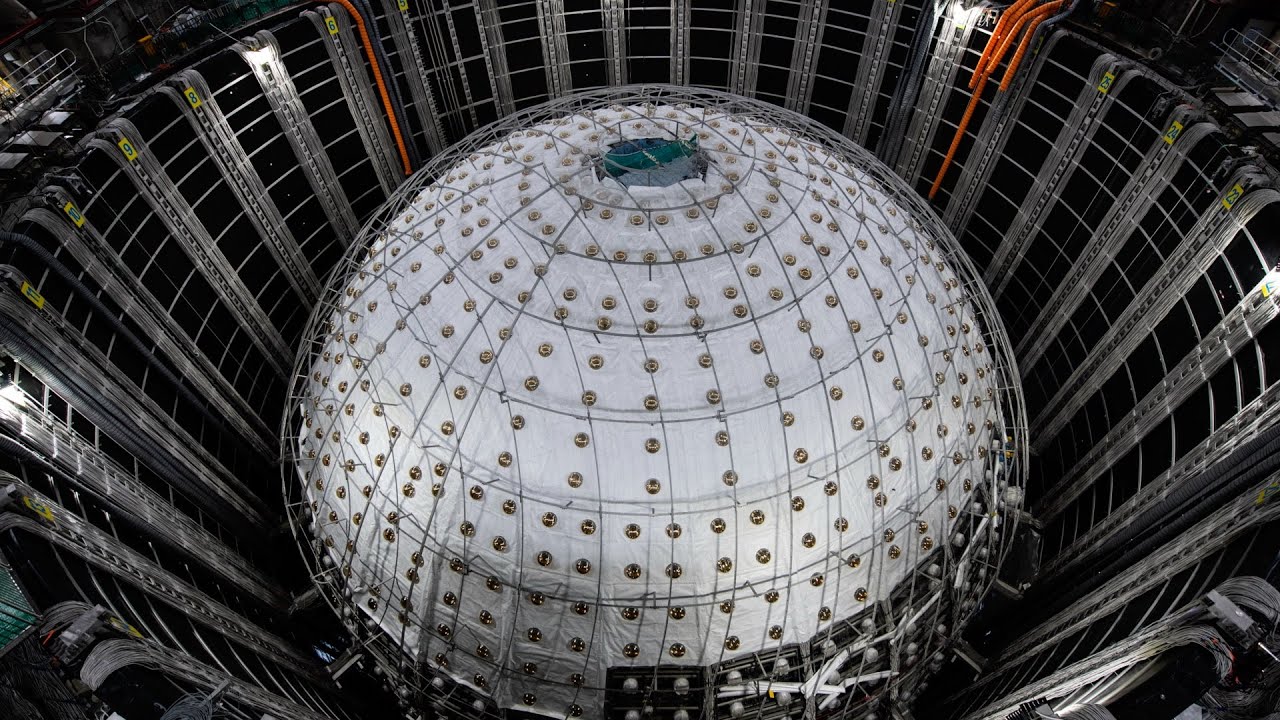
It's like something out of science fiction. In China, they've built a 35-meter plexiglass sphere 700 meters underground. It holds 20,000 tonnes of a strange liquid, surrounded by 43,200 photomultiplier tubes that can detect tiny flashes of light. It's deliberately built 50 kilometers from a nuclear reactor. It will start operation soon.
It's called JUNO, the Jiangmen Underground Neutrino Observatory. It should have been completed by November 2024. As usual there were delays, but it's been built now, and it should start taking data this fall.
The goal? To measure some numbers in a 3×3 matrix.
It's called the Pontecorvo–Maki–Nakagawa–Sakata matrix. Unless we are seriously confused — which is always possible — this matrix controls the behavior of the 3 kinds of neutrinos. Neutrinos of the first kind are produced as a byproduct of nuclear fission. But they can turn into the other kinds as they shoot along. The rate at which they do is in part described by this matrix. (It also depends on the masses of the 3 neutrinos.)
What's the use of this? Easy: one goal of any prosperous civilization has always been to better understand the universe. It's just a tiny part of the grand scheme. It usually comes well after the goal of eating lots of tasty foods, or watching people run around playing with spheres. But sometimes it has huge effects, and some of us find it very exciting.
It's a cruel fact that we can't measure neutrino masses by looking at how neutrinos oscillate back and forth between the 3 kinds. We can only measure the differences in the squares of their masses!
This creates a lot of difficulties. In particular, we're still not sure if there are two light neutrinos and one heavy, or two heavy neutrinos and one light. (They're all quite light, but the chart shows what I mean.)
The first scenario seems more likely from the data we have so far, so it's called the 'normal hierarchy'. The second is called the 'inverted hierarchy'.
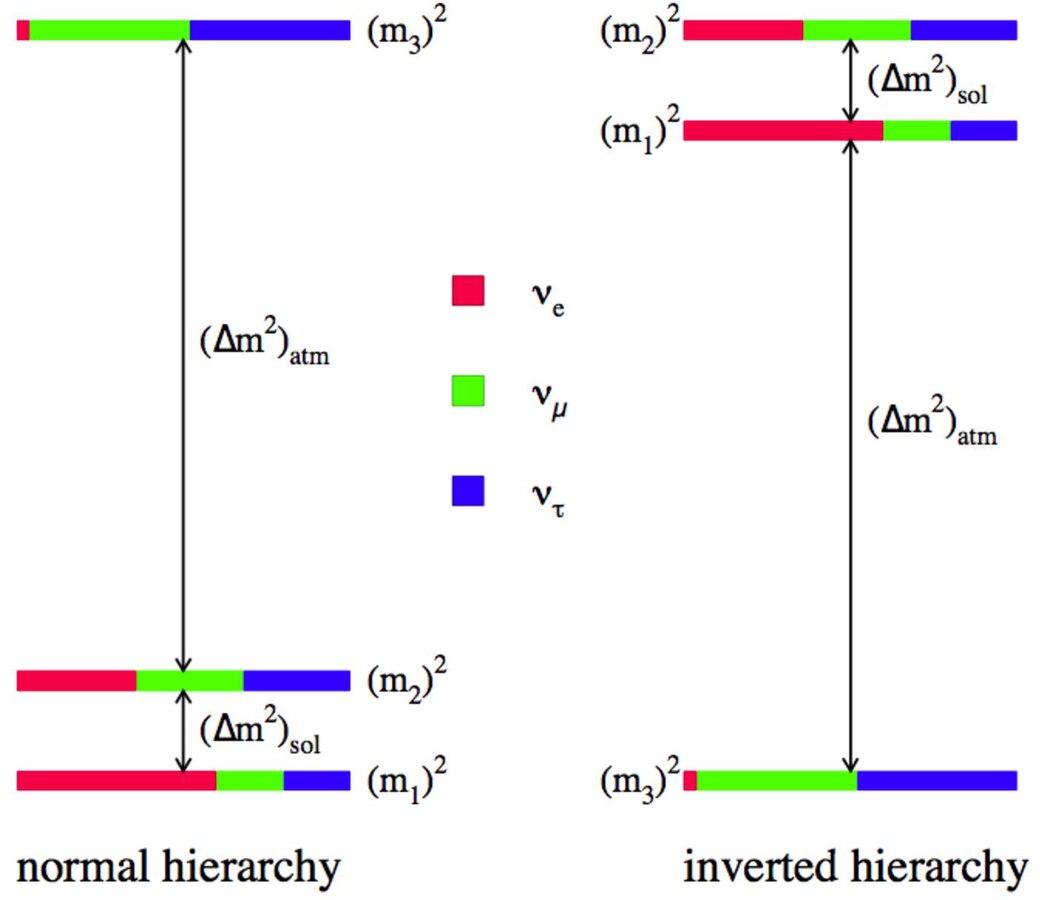
JUNO should help figure out which hierarchy is correct. It will also help with other questions. The three kinds of neutrino as measured by their mass are blends of the 3 kinds as measured by how they're produced and detected.
This blending is one of the things described by the Pontecorvo–Maki–Nakagawa–Sakata matrix. And it's also shown in the chart here.
The 3 kinds as measured by how they're produced and detected are called the e, μ and τ neutrinos. They're shown in red, green and blue in this chart. This chart shows how each of the 3 kinds as measured by mass is a mixture of red, green and blue!
For details on what we know and what JUNO will help figure out, try this:
Briefly, JUNO will help measure $$ m_2^2 - m_1^2 $$ and two other numbers that are functions of the Pontecorvo–Maki–Nakagawa–Sakata matrix elements. Alas, the numbers we can measure are not the numbers we most want to know!